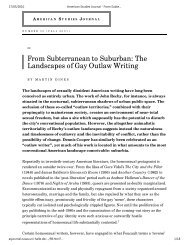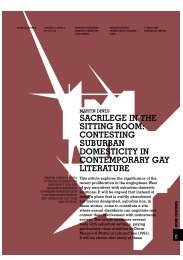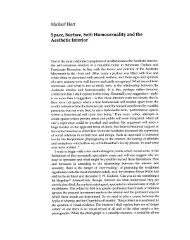Design, Materials, and Plants - Fritz Haeg
Design, Materials, and Plants - Fritz Haeg
Design, Materials, and Plants - Fritz Haeg
Create successful ePaper yourself
Turn your PDF publications into a flip-book with our unique Google optimized e-Paper software.
Sisyphus. Me? A case could certainly be made. Or was it the<br />
grass, pushing up through the soil every week, one layer of cells<br />
at a time, only to be cut down <strong>and</strong> then, perversely, encouraged<br />
(with fertilizer, lime, etc.) to start the whole doomed process<br />
over again? Another day it occurred to me that time as we know<br />
it doesn’t exist in the lawn, since grass never dies or is allowed<br />
to flower <strong>and</strong> set seed. Lawns are nature purged of sex <strong>and</strong><br />
death. No wonder Americans like them so much.<br />
And just where was my lawn, anyway? The answer’s not<br />
as obvious as it seems. Gardening, I had come to appreciate,<br />
is a painstaking exploration of place;<br />
everything that happens in my garden—<br />
the thriving <strong>and</strong> dying of particular<br />
plants, the maraudings of various<br />
insects <strong>and</strong> other pests—teaches me<br />
to know this patch of l<strong>and</strong> intimately,<br />
its geology <strong>and</strong> microclimate, the<br />
particular ecology of its local weeds<br />
<strong>and</strong> animals <strong>and</strong> insects. My garden<br />
prospers to the extent I grasp these<br />
particularities <strong>and</strong> adapt to them.<br />
Lawns work on the opposite principle.<br />
They depend for their success<br />
on the overcoming of local conditions.<br />
Like Jefferson superimposing one<br />
great grid over the infinitely various<br />
topography of the Northwest Territory,<br />
we superimpose our lawns on<br />
the l<strong>and</strong>. And since the geography<br />
<strong>and</strong> climate of much of this country<br />
are poorly suited to turfgrasses (none of which is native), this<br />
can’t be accomplished without the tools of twentieth-century<br />
industrial civilization—its chemical fertilizers, pesticides, herbicides,<br />
<strong>and</strong> machinery. For we won’t settle for the lawn that<br />
will grow here; we want the one that grows there, that dense<br />
springy supergreen <strong>and</strong> weed-free carpet, that Platonic ideal of<br />
a lawn we glimpse in the ChemLawn commercials, the magazine<br />
spreads, the kitschy sitcom yards, the sublime links <strong>and</strong><br />
pristine diamonds. Our lawns exist less here than there; they<br />
drink from the national stream of images, lift our gaze from the<br />
real places where we live <strong>and</strong> fix it on unreal places elsewhere.<br />
Lawns are a form of television.<br />
Need I point out that such an approach to “nature” is not<br />
likely to be environmentally sound? Lately we have begun to<br />
recognize that we are poisoning ourselves with our lawns,<br />
which receive, on average, more pesticide <strong>and</strong> herbicide per<br />
acre than just about any crop grown in this country. Suits<br />
fly against the national lawn-care companies, <strong>and</strong> interest is<br />
kindled in “organic” methods of lawn care. But the problem is<br />
larger than this. Lawns, I am convinced, are a symptom of, <strong>and</strong><br />
a metaphor for, our skewed relationship to the l<strong>and</strong>. They teach<br />
us that, with the help of petrochemicals <strong>and</strong> technology, we can<br />
bend nature to our will. Lawns stoke our hubris with regard to<br />
the l<strong>and</strong>. What is the alternative? To turn them into gardens. I’m<br />
not suggesting that there is no place for lawns in these gardens<br />
or that gardens by themselves will right our relationship to the<br />
l<strong>and</strong>, but the habits of thought they foster can take us some way<br />
in that direction.<br />
Gardening, as compared to lawn care, tutors us in nature’s<br />
ways, fostering an ethic of give <strong>and</strong> take with respect to the l<strong>and</strong>.<br />
Gardens instruct us in the particularities of place. They lessen<br />
our dependence on distant sources of energy, technology, food,<br />
<strong>and</strong>, for that matter, interest.<br />
For if lawn mowing feels like copying the same sentence over<br />
<strong>and</strong> over, gardening is like writing out new ones, an infinitely<br />
variable process of invention <strong>and</strong> discovery. Gardens also teach<br />
the necessary if rather un-American lesson that nature <strong>and</strong><br />
culture can be compromised, that there might be some middle<br />
ground between the lawn <strong>and</strong> the forest, between those who<br />
would complete the conquest of the planet in the name of<br />
progress, <strong>and</strong> those who believe it’s time we abdicated our rule<br />
<strong>and</strong> left the earth in the care of its more innocent species. The<br />
garden suggests there might be a place where we can meet<br />
nature half way.<br />
Probably you will want to know if I have begun to practice what<br />
I’m preaching. Well, I have not ripped out my lawn entirely. But<br />
each spring larger <strong>and</strong> larger tracts of it give way to garden.<br />
Last year I took a half acre <strong>and</strong> planted a meadow of black-eyed<br />
Susans <strong>and</strong> oxeye daisies. In return for a single annual scything,<br />
I am rewarded with a field of flowers from May until frost.<br />
The lawn is shrinking, <strong>and</strong> I’ve hired a neighborhood kid to<br />
mow what’s left of it. Any Saturday that Bon Jovi, Twisted Sister,<br />
or Van Halen isn’t playing the Hartford Civic Center, this large<br />
blond teen-aged being is apt to show up with a forty-eight-inch<br />
John Deere mower that shears the lawn in less than an hour. It’s<br />
thirty dollars a week, but he’s freed me from my dark musings<br />
about the lawn <strong>and</strong> so given me more time in the garden.<br />
Out in front, along the road where my lawn overlooks my<br />
neighbors’, <strong>and</strong> in turn the rest of the country’s, I have made my<br />
most radical move. I built a split-rail fence <strong>and</strong> have<br />
begun to plant a hedge along it, a rough one made up<br />
of forsythia, lilac, bittersweet, <strong>and</strong> bridal wreath. As<br />
soon as this hedge grows tall <strong>and</strong> thick, my secession<br />
from the national lawn will be complete.<br />
Anything then is possible. I could let it all revert to<br />
meadow, or even forest, except that I don’t go in for<br />
that sort of self-effacement. I could put in a pumpkin<br />
patch, a lily pond, or maybe an apple orchard. And I<br />
could even leave an area of grass. But even if I did, this<br />
would be a very different lawn from the one I have now.<br />
For one thing, it would have a frame, which means it<br />
could accommodate plants more subtle <strong>and</strong> various<br />
than the screaming marigolds, fierce red salvias,<br />
<strong>and</strong> musclebound rhododendrons that people usually<br />
throw into the ring against a big unfenced lawn. Walled<br />
off from the neighbors, no longer a tributary of the<br />
national stream, my lawn would now form a distinct<br />
<strong>and</strong> private space—become part of a garden, rather<br />
than a substitute for one.<br />
Yes, there might well be a place for a small lawn in my new<br />
garden. But I think I’ll wait until the hedge fills in before I make<br />
a decision. It’s a private matter, <strong>and</strong> I’m trying to keep politics<br />
out of it.<br />
Michael Pollan Why Mow? The Case Against Lawns<br />
34 edible estates Attack on the Front Lawn 35








